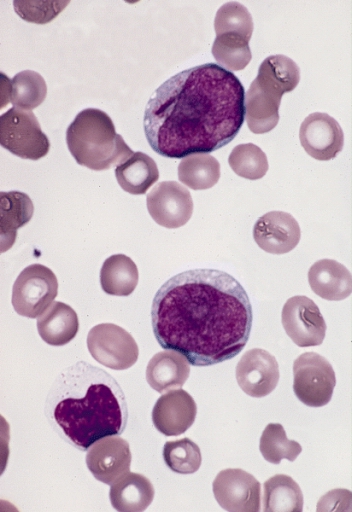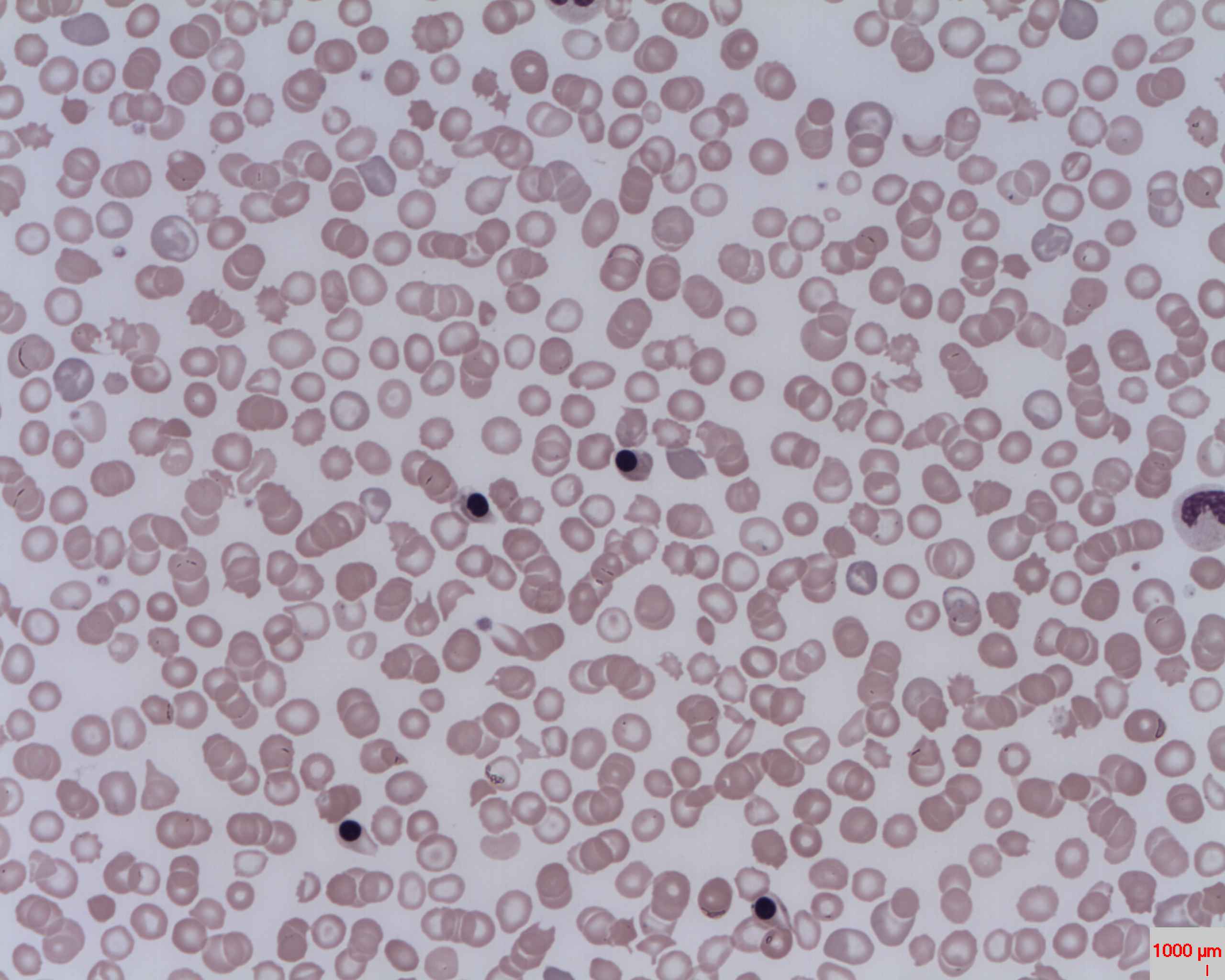|
French–American–British Classification
The French–American–British (FAB) classification systems refers to a series of classifications of hematologic diseases. It is based on the presence of dysmyelopoiesis and the quantification of myeloblasts and erythroblasts. It was first produced in 1976. Types include: * FAB classification of acute lymphoblastic leukemias: L1–L3 (three subtypes) * FAB classification of acute myeloid leukemia Acute myeloid leukemia (AML) is a cancer of the myeloid line of blood cells, characterized by the rapid growth of abnormal cells that build up in the bone marrow and blood and interfere with haematopoiesis, normal blood cell production. Sympt ...s: M0–M7 (eight subtypes) * FAB classification of myelodysplastic syndromes Updates continued through at least 1989. References Hematologic neoplasms {{med-diagnostic-stub ... [...More Info...] [...Related Items...] OR: [Wikipedia] [Google] [Baidu] |
Myeloblast
The myeloblast is a unipotent white blood cell which differentiates into the effectors of the granulocyte series. It is found in the bone marrow. Stimulation of myeloblasts by G-CSF and other cytokines triggers maturation, differentiation, proliferation and cell survival. Structure Myeloblasts reside extravascularly in the bone marrow. Hematopoiesis takes place in the extravascular cavities between the sinuses of the marrow. The wall of the sinuses is composed of two different types of cells, endothelial cells and adventitial reticular cells. The hemopoietic cells are aligned in cords or wedges between these sinuses, with myeloblasts and other granular progenitors concentrated in the subcortical regions of these hemopoietic cords. Myeloblasts are rather small cells with a diameter between 14 and 18μm. The major part is occupied by a large oval nucleus composed of very fine nonaggregated chromatin and possessing 3 or more nucleoli. The cytoplasm has a basophilic character an ... [...More Info...] [...Related Items...] OR: [Wikipedia] [Google] [Baidu] |
Erythroblast
A nucleated red blood cell (NRBC), also known by #Nomenclature, several other names, is a red blood cell that contains a cell nucleus. Almost all vertebrate organisms have hemoglobin-containing cells in their blood, and with the exception of mammals, all of these red blood cells are nucleated. In mammals, NRBCs occur in normal development as progenitor cell, precursors to mature red blood cells in erythropoiesis, the process by which the body produces red blood cells. NRBCs are normally found in the bone marrow of humans of all ages and in the blood of fetuses and infant, newborn infants. After infancy, RBCs normally contain a nucleus only during the very early stages of the cell's life, and the nucleus is ejected as a normal part of cellular differentiation before the cell is released into the bloodstream. The presence of circulating NRBCs in adults occurs in situations of hematopoietic stress such as severe infection, massive hemorrhage, marrow infiltration, or extramedullary he ... [...More Info...] [...Related Items...] OR: [Wikipedia] [Google] [Baidu] |
Acute Lymphoblastic Leukemia
Acute lymphoblastic leukemia (ALL) is a cancer of the Lymphocyte, lymphoid line of blood cells characterized by the development of large numbers of lymphoblast, immature lymphocytes. Symptoms may include feeling tired, pale skin color, fever, easy bleeding or bruising, lymphadenopathy, enlarged lymph nodes, or bone pain. As an acute leukemia, ALL progresses rapidly and is typically fatal within weeks or months if left untreated. In most cases, the cause is unknown. Genetic risk factors may include Down syndrome, Li–Fraumeni syndrome, or neurofibromatosis type 1. Environmental risk factors may include significant radiation exposure or prior chemotherapy. Evidence regarding electromagnetic fields or pesticides is unclear. Some hypothesize that an abnormal immune response to a common infection may be a trigger. The underlying mechanism involves multiple genetic mutations that results in rapid cell division. The excessive immature lymphocytes in the bone marrow interfere with t ... [...More Info...] [...Related Items...] OR: [Wikipedia] [Google] [Baidu] |
Acute Myeloid Leukemia
Acute myeloid leukemia (AML) is a cancer of the myeloid line of blood cells, characterized by the rapid growth of abnormal cells that build up in the bone marrow and blood and interfere with haematopoiesis, normal blood cell production. Symptoms may include Fatigue, feeling tired, shortness of breath, Bruise, easy bruising and bleeding, and increased risk of infection. Occasionally, spread may occur to the brain, skin, or gums. As an acute leukemia, AML progresses rapidly, and is typically fatal within weeks or months if left untreated. Risk factors include getting older, being male, smoking, previous chemotherapy or radiation therapy, myelodysplastic syndrome, and exposure to the chemical benzene. The underlying mechanism involves replacement of normal bone marrow with leukemia cells, which results in a anemia, drop in red blood cells, thrombocytopenia, platelets, and normal leukopenia, white blood cells. Diagnosis is generally based on bone marrow aspiration and specific bl ... [...More Info...] [...Related Items...] OR: [Wikipedia] [Google] [Baidu] |
Myelodysplastic Syndrome
A myelodysplastic syndrome (MDS) is one of a group of cancers in which blood cells in the bone marrow do not mature, and as a result, do not develop into healthy blood cells. Early on, no symptoms typically are seen. Later, symptoms may include fatigue, shortness of breath, bleeding disorders, anemia, or frequent infections. Some types may develop into acute myeloid leukemia. Risk factors include previous chemotherapy or radiation therapy, exposure to certain chemicals such as tobacco smoke, pesticides, and benzene, and exposure to heavy metals such as Mercury (element), mercury or lead. Problems with blood cell formation result in some combination of low anemia, red blood cell, thrombocytopenia, platelet, and white blood cell counts. Some types of MDS cause an increase in the production of immature blood cells (called blast cell, blasts), in the bone marrow or peripheral blood, blood. The different types of MDS are identified based on the specific characteristics of the chang ... [...More Info...] [...Related Items...] OR: [Wikipedia] [Google] [Baidu] |

